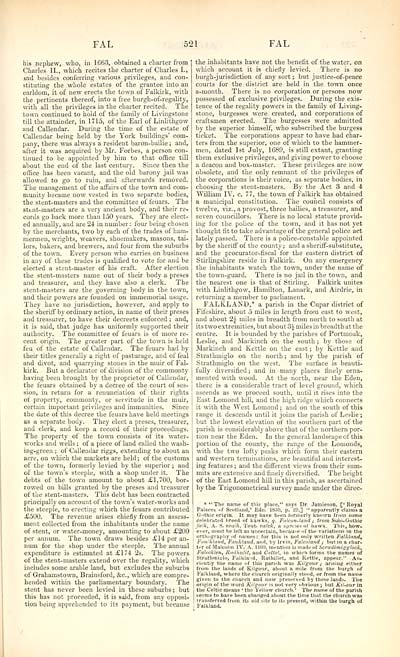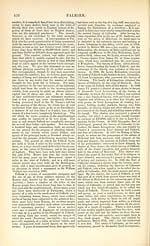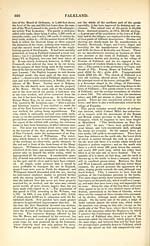Topographical, statistical, and historical gazetteer of Scotland > Volume 1
(615) Page 521
Download files
Complete book:
Individual page:
Thumbnail gallery: Grid view | List view

FAL
521
FAL
his nephew, wbo, in 1663, obtained a charter from
Charles II., which recites the charter of Charles I.,
ind besides conferring various privileges, and con-
stituting the whole estates of the grantee into an
earldom, it of new erects the town of Falkirk, with
the pertinents thereof, into a free burgh-of-regality,
with all the privileges in the charter recited. The
town continued to hold of the family of Livingstone
till the attainder, in 1715, of the Earl of Linlithgow
and Callendar. During the time of the estate of
Callendar being held by the York buildings' com-
pany, there was always a resident baron-bailie ; and,
after it was acquired by Mr. Forbes, a person con-
tinued to be appointed by him to that office till
about the end of the last century. Since then the
office has been vacant, and the old barony jail was
allowed to go to ruin, and afterwards removed.
The management of the affairs of the town and com-
munity became now vested in two separate bodies,
the stent-masters and the committee of feuars. The
sttnt-masters are a very ancient body, and their re-
cords go back more than 150 years. They are elect-
ed annually, and are 24 in number : four being chosen
by the merchants, two by each of the trades of ham-
mermen, wrights, weavers, shoemakers, masons, tai-
lors, bakers, and brewers, and four from the suburbs
of the town. Every person who carries on business
in any of these trades is qualified to vote for and be
elected a stent-master of his craft. After election
the stent-masters name out of their body a preses
and treasurer, and they have also a clerk. The
stent-masters are the governing body in the town,
and their powers are founded on immemorial usage.
They have no jurisdiction, however, and apply to
the sheriff by ordinary action, in name of their preses
and treasurer, to have their decreets enforced ; and,
it is said, that judge has uniformly supported their
authority. The committee of feuars is of more re-
cent origin. The greater part of the town is held
feu of the estate of Callendar. The feuars had by
their titles generally a right of pasturage, and of feal
and divot, and quarrying stones in the muir of Fal-
kirk. But a declarator of division of the commonty
having been brought by the proprietor of Callendar,
the feuars obtained by a decree of the court of ses-
sion, in return for a renunciation of their rights
of property, commonty, or servitude in the muir,
certain important privileges and immunities. Since
the date of this decree the feuars have held meetings
as a separate body. They elect a preses, treasurer,
and clerk, and keep a record of their proceedings.
The property of the town consists of its water-
works and wells ; of a piece of land called the wash-
ing-green ; of Callendar riggs, extending to about an
acre, on which the markets are held; of the customs
of the town, formerly levied by the superior ; and
of the town's steeple, with a shop under it. The
debts of the town amount to about £1,700, bor-
rowed on bills granted by the preses and treasurer
of the stent-masters. This debt has been contracted
principally on account of the town's water- works and
the steeple, to erecting which the feuars contributed
£500. The revenue arises chiefly from an assess-
ment collected from the inhabitants under the name
of stent, or water-money, amounting to about £200
per annum. The town draws besides £14 per an-
num for the shop under the steeple. The annual
expenditure is estimated at £174 2s. The powers
of the stent-masters extend over the regality, which
includes some arable land, but excludes the suburbs
of Grahamstown, Brainsford, &c, which are compre-
hended within the parliamentary boundary. The
stent has never been levied in these suburbs ; but
this has not proceeded, it is said, from any opposi-
tion being apprehended to its payment, but because
the inhabitants have not the benefit of the water, on
which account it is chiefly levied. There is no
burgh -jurisdiction of any sort ; but justice-of-peace
courts for the district are held in the town once
a-month. There is no corporation or persons now
possessed of exclusive privileges. During the exis-
tence of the regality powers in the family of Living-
stone, burgesses were created, and corporations of
craftsmen erected. The burgesses were admitted
by the superior himself, who subscribed the burgess
ticket. The corporations appear to have had char-
ters from the superior, one of which to the hammer-
men, dated 1st July, 1689, is still extant, granting
them exclusive privileges, and giving power to choose
a deacon and box-master. These privileges are now
obsolete, and the only remnant of the privileges of
the corporations is their voice, as separate bodies, in
choosing the stent-masters. By the Act 3 and 4
William IV. c. 77, the town of Falkirk has obtained
a municipal constitution. The council consists of
twelve, viz., a provost, three bailies, a treasurer, and
seven councillors. There is no local statute provid-
ing for the police of the town, and it has not yet
thought fit to take advantage of the general police act
lately passed. There is a police-constable appointed
by the sheriff of the county; and a sheriff-substitute,
and the procurator-fiscal for the eastern district of
Stirlingshire reside in Falkirk. On any emergency
the inhabitants watch the town, under the name of
the town-guard. There is no jail in the town, and
the nearest one is that of Stirling. Falkirk unites
with Linlithgow, Hamilton, Lanark, and Airdrie, in
returning a member to parliament.
FALKLAND,* a parish in the Cupar district of
Fifeshire, about 5 miles in length from east to west,
and about 2i miles in breadth from north to south at
its two extremities, but about 3i miles in breadth at the
centre. It is bounded by the parishes of Portmoak,
Leslie, and Markinch on the south ; by those of
Markinch and Kettle on the east ; by Kettle and
Stratkmiglo on the north; and by the parish of
Strathmiglo on the west. The surface is beauti-
fully diversified ; and in many places finely orna-
mented with wood. At the north, near the Eden,
there is a considerable tract of level ground, which
ascends as we proceed south, until it rises into the
East Lomond hill, and the high ridge which connects
it with the West Lomond ; and on the south of this
range it descends until it joins the parish of Leslie ;
but the lowest elevation of the southern part of the
parish is considerably above that of the northern por-
tion near the Eden. In the general landscape of this
portion of the county, the range of the Lomonds,
with the two lofty peaks which form their eastern
and western terminations, are beautiful and interest-
ing features ; and the different views from their sum-
mits are extensive and finely diversified. The height
of the East Lomond hill in this parish, as ascertained
by the Trigonometrical survey made under the direc-
*"The name of this place," says Dr. Jamieson, ['Royal
I Palaces of Scotland,' Edu. 1830, p. 29,] " apparently claims a
] Gothic origin. It may have been formerly known from some
celebrated breed of kawks. q. Falcon-land ; from Suio-Gothic
folk, A. S. vfialh, Tent, valck, a species of hawk. This, how-
'■ ever, innst be left as uncertain, because of the variations in the
| orthography of names: for this is not only written Falkland,
■ Faulkland, Faukland, and, by Irvin, Falcoland ,■ but in a ehar-
i ter of Malcolm IV. A. 1160, mention is made of Scradimigglock,
Faleckten, Radliulit, and Catlel, in which forms the names of
: Strathmiglo, Falkland, Rathillet, and Kettle, appear." An.
t ciently the name of this parish was Kilgour ; arising either
from the lands of Kilgour, about a roile from the burgh of
Falkland, where the church originally stood, or from the name
given to the church and now preserved by these lands. The
origio of the word Kilgour is not very obvious ; but Kil-our in
the Celtic means 'the Yellow church.' The name of the parish
seems to have been changed about the time that the church was
transferred from its old site to its present, within the burgh of
Falkland.
521
FAL
his nephew, wbo, in 1663, obtained a charter from
Charles II., which recites the charter of Charles I.,
ind besides conferring various privileges, and con-
stituting the whole estates of the grantee into an
earldom, it of new erects the town of Falkirk, with
the pertinents thereof, into a free burgh-of-regality,
with all the privileges in the charter recited. The
town continued to hold of the family of Livingstone
till the attainder, in 1715, of the Earl of Linlithgow
and Callendar. During the time of the estate of
Callendar being held by the York buildings' com-
pany, there was always a resident baron-bailie ; and,
after it was acquired by Mr. Forbes, a person con-
tinued to be appointed by him to that office till
about the end of the last century. Since then the
office has been vacant, and the old barony jail was
allowed to go to ruin, and afterwards removed.
The management of the affairs of the town and com-
munity became now vested in two separate bodies,
the stent-masters and the committee of feuars. The
sttnt-masters are a very ancient body, and their re-
cords go back more than 150 years. They are elect-
ed annually, and are 24 in number : four being chosen
by the merchants, two by each of the trades of ham-
mermen, wrights, weavers, shoemakers, masons, tai-
lors, bakers, and brewers, and four from the suburbs
of the town. Every person who carries on business
in any of these trades is qualified to vote for and be
elected a stent-master of his craft. After election
the stent-masters name out of their body a preses
and treasurer, and they have also a clerk. The
stent-masters are the governing body in the town,
and their powers are founded on immemorial usage.
They have no jurisdiction, however, and apply to
the sheriff by ordinary action, in name of their preses
and treasurer, to have their decreets enforced ; and,
it is said, that judge has uniformly supported their
authority. The committee of feuars is of more re-
cent origin. The greater part of the town is held
feu of the estate of Callendar. The feuars had by
their titles generally a right of pasturage, and of feal
and divot, and quarrying stones in the muir of Fal-
kirk. But a declarator of division of the commonty
having been brought by the proprietor of Callendar,
the feuars obtained by a decree of the court of ses-
sion, in return for a renunciation of their rights
of property, commonty, or servitude in the muir,
certain important privileges and immunities. Since
the date of this decree the feuars have held meetings
as a separate body. They elect a preses, treasurer,
and clerk, and keep a record of their proceedings.
The property of the town consists of its water-
works and wells ; of a piece of land called the wash-
ing-green ; of Callendar riggs, extending to about an
acre, on which the markets are held; of the customs
of the town, formerly levied by the superior ; and
of the town's steeple, with a shop under it. The
debts of the town amount to about £1,700, bor-
rowed on bills granted by the preses and treasurer
of the stent-masters. This debt has been contracted
principally on account of the town's water- works and
the steeple, to erecting which the feuars contributed
£500. The revenue arises chiefly from an assess-
ment collected from the inhabitants under the name
of stent, or water-money, amounting to about £200
per annum. The town draws besides £14 per an-
num for the shop under the steeple. The annual
expenditure is estimated at £174 2s. The powers
of the stent-masters extend over the regality, which
includes some arable land, but excludes the suburbs
of Grahamstown, Brainsford, &c, which are compre-
hended within the parliamentary boundary. The
stent has never been levied in these suburbs ; but
this has not proceeded, it is said, from any opposi-
tion being apprehended to its payment, but because
the inhabitants have not the benefit of the water, on
which account it is chiefly levied. There is no
burgh -jurisdiction of any sort ; but justice-of-peace
courts for the district are held in the town once
a-month. There is no corporation or persons now
possessed of exclusive privileges. During the exis-
tence of the regality powers in the family of Living-
stone, burgesses were created, and corporations of
craftsmen erected. The burgesses were admitted
by the superior himself, who subscribed the burgess
ticket. The corporations appear to have had char-
ters from the superior, one of which to the hammer-
men, dated 1st July, 1689, is still extant, granting
them exclusive privileges, and giving power to choose
a deacon and box-master. These privileges are now
obsolete, and the only remnant of the privileges of
the corporations is their voice, as separate bodies, in
choosing the stent-masters. By the Act 3 and 4
William IV. c. 77, the town of Falkirk has obtained
a municipal constitution. The council consists of
twelve, viz., a provost, three bailies, a treasurer, and
seven councillors. There is no local statute provid-
ing for the police of the town, and it has not yet
thought fit to take advantage of the general police act
lately passed. There is a police-constable appointed
by the sheriff of the county; and a sheriff-substitute,
and the procurator-fiscal for the eastern district of
Stirlingshire reside in Falkirk. On any emergency
the inhabitants watch the town, under the name of
the town-guard. There is no jail in the town, and
the nearest one is that of Stirling. Falkirk unites
with Linlithgow, Hamilton, Lanark, and Airdrie, in
returning a member to parliament.
FALKLAND,* a parish in the Cupar district of
Fifeshire, about 5 miles in length from east to west,
and about 2i miles in breadth from north to south at
its two extremities, but about 3i miles in breadth at the
centre. It is bounded by the parishes of Portmoak,
Leslie, and Markinch on the south ; by those of
Markinch and Kettle on the east ; by Kettle and
Stratkmiglo on the north; and by the parish of
Strathmiglo on the west. The surface is beauti-
fully diversified ; and in many places finely orna-
mented with wood. At the north, near the Eden,
there is a considerable tract of level ground, which
ascends as we proceed south, until it rises into the
East Lomond hill, and the high ridge which connects
it with the West Lomond ; and on the south of this
range it descends until it joins the parish of Leslie ;
but the lowest elevation of the southern part of the
parish is considerably above that of the northern por-
tion near the Eden. In the general landscape of this
portion of the county, the range of the Lomonds,
with the two lofty peaks which form their eastern
and western terminations, are beautiful and interest-
ing features ; and the different views from their sum-
mits are extensive and finely diversified. The height
of the East Lomond hill in this parish, as ascertained
by the Trigonometrical survey made under the direc-
*"The name of this place," says Dr. Jamieson, ['Royal
I Palaces of Scotland,' Edu. 1830, p. 29,] " apparently claims a
] Gothic origin. It may have been formerly known from some
celebrated breed of kawks. q. Falcon-land ; from Suio-Gothic
folk, A. S. vfialh, Tent, valck, a species of hawk. This, how-
'■ ever, innst be left as uncertain, because of the variations in the
| orthography of names: for this is not only written Falkland,
■ Faulkland, Faukland, and, by Irvin, Falcoland ,■ but in a ehar-
i ter of Malcolm IV. A. 1160, mention is made of Scradimigglock,
Faleckten, Radliulit, and Catlel, in which forms the names of
: Strathmiglo, Falkland, Rathillet, and Kettle, appear." An.
t ciently the name of this parish was Kilgour ; arising either
from the lands of Kilgour, about a roile from the burgh of
Falkland, where the church originally stood, or from the name
given to the church and now preserved by these lands. The
origio of the word Kilgour is not very obvious ; but Kil-our in
the Celtic means 'the Yellow church.' The name of the parish
seems to have been changed about the time that the church was
transferred from its old site to its present, within the burgh of
Falkland.
Set display mode to: Large image | Transcription
Images and transcriptions on this page, including medium image downloads, may be used under the Creative Commons Attribution 4.0 International Licence unless otherwise stated. ![]()
| Gazetteers of Scotland, 1803-1901 > Topographical, statistical, and historical gazetteer of Scotland > Volume 1 > (615) Page 521 |
|---|
| Permanent URL | https://digital.nls.uk/97444926 |
|---|
| Description | Volume first. A-H. |
|---|---|
| Attribution and copyright: |
|

